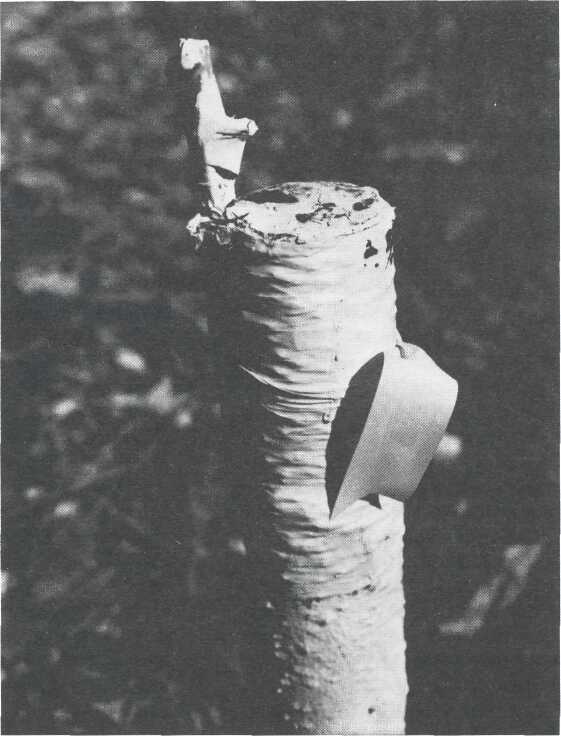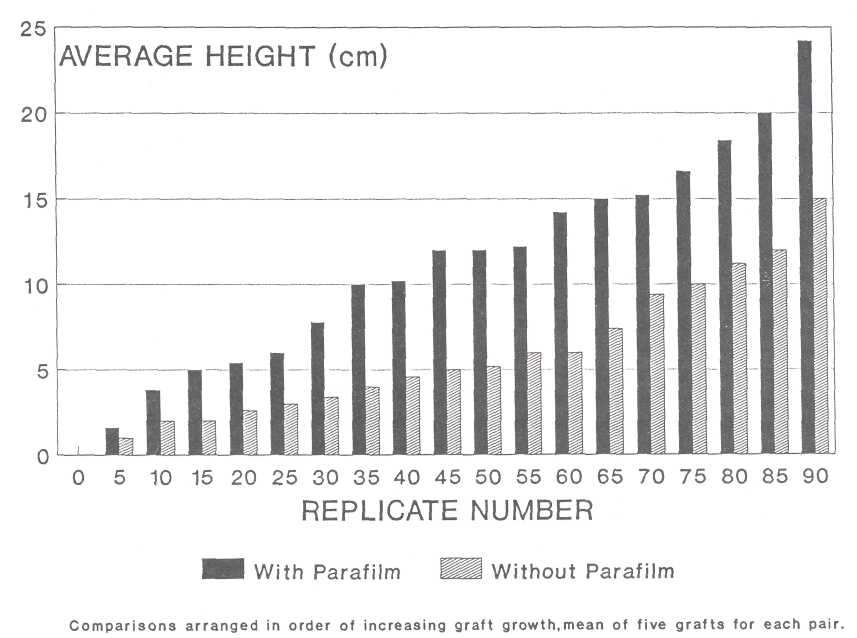Proc. of
Avocado Topworking Update 1990
Gray
Martin and Bob Bergh
Department
of Botany and Plant Sciences,
Abstract. As total avocado acreage shrinks in
LARGE TREES (more than 25 cm in diameter)
Past
Historically,
large trees were "notch" ("sawkerf")
grafted in early spring. A skilled propagator can achieve excellent results
with this graft; tree growth is vigorous, percent take is high, and the
scion/stock union is strong and well-healed. However, this propagation
technique is quite difficult and requires specialized tools. The procedure is
slow, and also is best performed with large-diameter scion wood.
Present
Bark grafting. Bark grafting
using large-diameter trees has not generally been very successful. It helps to
reduce the thickness of the bark using the edge of a pruning saw blade, or
other shaving tool, to make the bark less brittle for scion insertion. Also,
the standard one-inch wrapping tape generally does not provide adequate
pressure on bark and scion to create a strong cambium attachment. Roofing
staples have been successful in binding the scion tightly, but as the scion
grows and enlarges, the staples pinch, restricting expansion, and creating a
permanent weakness at the graft union. Small nails or brads have been used with
limited success. This procedure requires more time and labor.
Summer shoot grafting. To
commercially graft large acreage quickly and economically, Mr. Richard Marocco, of Fallbrook Ag-Laboratories, Inc.,
The
summer shoot grafting technique requires stumping trees at about 60 cm early in
spring after the danger of frost has passed. From the mass of shoot regrowth, both from the stump and the rootstock (below
ground), 3 to 4 vigorous shoots are selected, of which two or more are grafted
with a modified splice graft in mid- to late-summer. Success rate with this
graft is high, but it is not without some disadvantages. First, grafting late
in the year requires the use of freshly picked summer wood. Unlike dormant wood
used for spring grafting, summer wood cannot be cold-stored for prolonged
periods of time. Second, there may be erratic stump regrowth
from any of several causes: inherent tree variability, excess soil moisture
accumulation during a period of no evapotranspiration
requirement, and soil moisture deficit after regrowth
activity. Third, very late-season grafting frequently does not produce sizable
trees before the cold of winter. Thus, danger of cold damage is more likely on
summer-grafted trees. Grafts must be firmly staked; the stock shoot attachment
and the fragile scion/stock attachment is vulnerable
to breakage early in the graft development.
Future
Grafting over-wintered suckers. A
promising new approach is to stump the trees as for summer shoot grafting, but
to delay the grafting until the following spring. By allowing the tree to regrow for about one year, the original stumping shock is
past, and initial graft growth response is vigorous. (Conversely, summer shoot
grafting failure can weaken the tree so that it is permanently injured by
summer heat stress or later winter cold.)
Similar
to summer shoot grafting, two or more over-wintered shoots should be
bark-grafted in early spring. The shoot will have green bark, and will
generally slip year-round. Early season grafting will establish a long growing
season for the young graft, although grafting too early may result in freeze
damage. By keeping one or two nurse limbs until graft growth is healthy and
about a height of 30 cm, the vigor of the tree and growth cycle of the stump is
sustained. Additionally, although stakes are still required to prevent
top-heavy shoots from breaking, staking is not as critical as for other graft
methods; the active cambium development of the young shoot combined with a full
season of growth usually produces a smooth and complete stock-graft union that
is quite strong.
Currently,
there are no production data comparing summer shoot
grafting with over-wintered shoot grafting. In one trial using the 'Gwen'
cultivar, some fruit was observed on the summer shoot grafted trees less than
one year from grafting. The economic value of this crop is relatively small,
and may retard early tree development; vegetative growth is suppressed by the
burden of maturing fruit and so these fruit should probably be removed.
SMALLER FIELD TREES (« 20 cm in diameter)
Here
the bark graft works well on the original stump cut. Grafting is generally done
after the danger of frost and requires slipping bark. Commercial propagator Mr.
Alvin Lypps of
Budding
Budding
is generally not recommended for avocado, particularly in topworking.
The protruding nature of the avocado bud is susceptible to physical damage from
the plastic tape wrap required to protect the small bud-shield from seasonal
dry heat. Yet, if performed successfully, budding can be a relatively easy
propagation method, and can utilize buds from immature or green succulent
shoots, not typically suitable for grafting. It requires young bark, such as on
sucker shoots.
A
successful procedure is to use a standard ‘T' bud cut, wrapping the bark over
the bud-shield with plastic tape, leaving the bud eye exposed. Then, second-wrap with a light-mil (1 mil) tape that is elastic enough
to prevent bud damage. The second wrap is removed after a period of
about 2 weeks to prevent sealed moisture from causing rot and after enough time
for the bud-shield attachment to be complete. At such time, the budded shoot is
cut 15 to 20 cm above the bud to force bud growth and to remove growth
competition from the terminal dominant shoots. A cut through the bark just
above the bud may additionally be helpful in forcing the bud to grow.
GRAFT CARE
Wrapping
Perhaps
one of the most important contributions to the success of grafting since
plastic tape and asphalt emulsion is a wax-like stretchable tape called 'Parafilm’R. The material is now used by
propagators on different species, but its usage on avocado owes its popularity
to Rick Marocco of Fallbrook. Although there are many
different techniques using the Parafilm product, the
common use is to wrap the entire scion, stem and buds (Fig. 1). Buds grow
through the Parafilm and therefore removal is not
required (Fig. 2). In one large-scale experiment (Fig. 3), by 10 weeks after
grafting, Parafilm treatment had resulted in almost
twice as much graft growth, an average length of 11.6 cm compared with 6.1 cm
for the controls (P < 0.001).
More
experience is needed to utilize the full potential of the Parafilm
product. For example, Mr. Marocco wraps not only the
scion but also the scion/stock cuts, thus making the usual plastic wrapping
unnecessary, and therefore eliminating the need to return at a later date to
cut plastic from the expanding graft. Mr. Marocco's
results have been excellent, but Parafilm is not as
strong as plastic and is not as effective for all grafts. Other nurserymen have
combined the use of Parafilm with budding rubber
bands. Placing the rubber bands over the Parafilm
helps to reinforce the scion/stock union. Like Parafilm,
rubber bands break down with exposure to heat and light. In order to prevent
too quick decomposition, the film must be shielded from direct exposure to
light. Typically, white paper or paper-backed aluminum are
placed over the material. Dilute, light-colored,
water-base paint on the outside of the Parafilm tape
has been used with varying degrees of success. Parafilm
comes in three types: clear transparent, white opaque, and green translucent. We
know very little about the response of white and green Parafilm
at this time.
Wound Compounds
Using
Parafilm on small-diameter scion/stock grafts
eliminates the need for asphalt emulsion as a seal. But, when grafting
larger-diameter stocks, asphalt emulsion is necessary to prevent sapwood drying
and cambium injury. Typically, asphalt is used at a consistency designed by the
manufacturer. It is easy to apply and is an excellent sealant for cut surfaces
and exposed cambium. But, the effectiveness of this sealant can encourage Poria fungal rot to travel through the heart
of the tree causing structural weakness. Therefore, it is advisable to dilute
the asphalt emulsion for general application, using the thicker full-strength
material to fill larger gaps. This treatment has been found to minimize both
desiccation and disease.
Asphalt
emulsion is black and tar-like. If it is exposed to direct sunlight, heat can
transfer to the tender scions and cause severe damage, even if the scions
themselves are not directly exposed. Therefore, cover all asphalt sealant with a white (or light-colored) water-base paint. We are
searching for a light-colored sealant to replace asphalt emulsion, so far
unsuccessfully. It is also advisable to paint the bark of the stock, which is
now exposed to the sun because of tree top removal.
Coverings
In
hot climates, it is best to protect the newly grafted scions with something
like a multiple-layered white paper cone wrapped around the stump, bound with
twine or stapled, and supported with small bamboo stakes or the equivalent. The
stakes keep the paper from sagging from moisture or bird perching. Before
summer heat, cut vents in the side of the cover to prevent heat buildup.
Paper-lined aluminum has been used very successfully as a cover; the reflectivesurface of the aluminum reduces heat buildup. In
a simple test, paper-backed aluminum maintained inside temperatures more than
6.67C cooler than did brown paper wraps, under conditions of sun exposure
averaging 37.78C. The aluminum cover permits successful bark grafting as late
as mid-summer. The aluminum cover may alter the optimum grafting season in our
area (conventionally early March to mid-May) to April-August, when the rootstock
is more actively growing.
Pruning
Frequently,
no training (other than staking) is given to successful grafts. This is a
cultural-care oversight. Neglected topworked trees
appear on the surface to be healthy, but examination reveals competing
structural limbs or weak crotches likely to break under the strain of a crop
load or high winds. After grafting, the newly developing scion commonly has
more than one shoot. At a height of about 15 to 40 cm, it is advisable to pinch
terminal portions of all but the best-placed, dominant shoot to create a strong
central leader. Sometimes repeat pinchings are
desirable to enhance the central leader. In a month or two, the dominant trunk
becomes the established tree and secondary shoots are removed entirely.
After
the above procedure has produced a single strong trunk, upright growing
varieties like ‘Gwen’ can be height controlled by a switch in logic: remove the
tip of the central leader to encourage tree spread. How this response, or other
pruning treatment combinations, will affect tree height and yield is the
purpose of an ongoing study.
LITERATURE CITED
Whitsell, R.H., G.E. Martin, B.O. Bergh,
A.V. Lypps, and W.H. Brokaw. 1989. Propagating Avocados.
|
|
|
Figure 1. Parafilm wrapping stem and buds of avocado scion. |
|
|
|
|
Figure 2. Avocado shoot growth through Parafilm
two months after grafting. |
|
|
|
|
|
Figure 3. Comparative
effect of Parafilm treatment on growth of 'Gwen'
grafts. |
|


